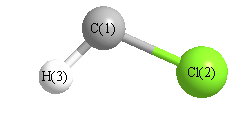Jump to
S2C1
Energy calculated at B3LYP/6-311G*
| | hartrees |
|---|
| Energy at 0K | -498.799601 |
| Energy at 298.15K | -498.799453 |
| HF Energy | -498.799601 |
| Nuclear repulsion energy | 38.227725 |
The energy at 298.15K was derived from the energy at 0K
and an integrated heat capacity that used the calculated vibrational frequencies.
Geometric Data calculated at B3LYP/6-311G*
Point Group is Cs
Cartesians (Å)
| Atom |
x (Å) |
y (Å) |
z (Å) |
|---|
| C1 |
0.045 |
1.210 |
0.000 |
| Cl2 |
0.045 |
-0.512 |
0.000 |
| H3 |
-1.044 |
1.436 |
0.000 |
Atom - Atom Distances (Å)
| |
C1 |
Cl2 |
H3 |
| C1 | | 1.7221 | 1.1127 |
Cl2 | 1.7221 | | 2.2314 | H3 | 1.1127 | 2.2314 | |
 More geometry information
More geometry information
Calculated Bond Angles
| atom1 |
atom2 |
atom3 |
angle |
|
atom1 |
atom2 |
atom3 |
angle |
| Cl2 |
C1 |
H3 |
101.671 |
|
Electronic energy levels
Charges, Dipole, Quadrupole and Polarizability
Charges from optimized geometry at B3LYP/6-311G*
Charges (e)
| Number |
Element |
Mulliken |
CHELPG |
AIM |
ESP |
| 1 |
C |
-0.271 |
|
|
|
| 2 |
Cl |
0.050 |
|
|
|
| 3 |
H |
0.220 |
|
|
|
Electric dipole moments
Electric dipole components in Debye
(What's a Debye? See section
VII.A.3)
| |
x |
y |
z |
Total |
| |
-1.608 |
-0.501 |
0.000 |
1.685 |
| CHELPG |
|
|
|
|
| AIM |
|
|
|
|
| ESP |
|
|
|
|
Electric Quadrupole moment
Quadrupole components in D Å
| Primitive |
|---|
| | x | y | z |
|---|
| x |
-19.839 |
-2.677 |
0.000 |
| y |
-2.677 |
-20.448 |
0.000 |
| z |
0.000 |
0.000 |
-18.306 |
|
| Traceless |
|---|
| | x | y | z |
|---|
| x |
-0.462 |
-2.677 |
0.000 |
| y |
-2.677 |
-1.375 |
0.000 |
| z |
0.000 |
0.000 |
1.837 |
|
| Polar |
|---|
| 3z2-r2 | 3.674 |
|---|
| x2-y2 | 0.608 |
|---|
| xy | -2.677 |
|---|
| xz | 0.000 |
|---|
| yz | 0.000 |
|---|
|
Polarizabilities
Components of the polarizability tensor.
Units are
Å
3 (Angstrom cubed)
Change units.
| |
x |
y |
z |
| x |
2.318 |
-0.326 |
0.000 |
| y |
-0.326 |
4.966 |
0.000 |
| z |
0.000 |
0.000 |
1.840 |
<r2> (average value of r
2) Å
2
| <r2> |
28.639 |
| (<r2>)1/2 |
5.352 |
Jump to
S1C1
Energy calculated at B3LYP/6-311G*
| | hartrees |
|---|
| Energy at 0K | -498.794490 |
| Energy at 298.15K | -498.794332 |
| HF Energy | -498.794490 |
| Nuclear repulsion energy | 38.708603 |
The energy at 298.15K was derived from the energy at 0K
and an integrated heat capacity that used the calculated vibrational frequencies.
Geometric Data calculated at B3LYP/6-311G*
Point Group is Cs
Cartesians (Å)
| Atom |
x (Å) |
y (Å) |
z (Å) |
|---|
| C1 |
0.037 |
1.163 |
0.000 |
| Cl2 |
0.037 |
-0.516 |
0.000 |
| H3 |
-0.847 |
1.794 |
0.000 |
Atom - Atom Distances (Å)
| |
C1 |
Cl2 |
H3 |
| C1 | | 1.6790 | 1.0857 |
Cl2 | 1.6790 | | 2.4733 | H3 | 1.0857 | 2.4733 | |
 More geometry information
More geometry information
Calculated Bond Angles
| atom1 |
atom2 |
atom3 |
angle |
|
atom1 |
atom2 |
atom3 |
angle |
| Cl2 |
C1 |
H3 |
125.547 |
|
Electronic energy levels
Charges, Dipole, Quadrupole and Polarizability
Charges from optimized geometry at B3LYP/6-311G*
Charges (e)
| Number |
Element |
Mulliken |
CHELPG |
AIM |
ESP |
| 1 |
C |
-0.306 |
|
|
|
| 2 |
Cl |
0.047 |
|
|
|
| 3 |
H |
0.259 |
|
|
|
Electric dipole moments
Electric dipole components in Debye
(What's a Debye? See section
VII.A.3)
| |
x |
y |
z |
Total |
| |
-0.843 |
0.379 |
0.000 |
0.925 |
| CHELPG |
|
|
|
|
| AIM |
|
|
|
|
| ESP |
|
|
|
|
Electric Quadrupole moment
Quadrupole components in D Å
| Primitive |
|---|
| | x | y | z |
|---|
| x |
-18.700 |
-1.563 |
0.000 |
| y |
-1.563 |
-17.447 |
0.000 |
| z |
0.000 |
0.000 |
-19.929 |
|
| Traceless |
|---|
| | x | y | z |
|---|
| x |
-0.013 |
-1.563 |
0.000 |
| y |
-1.563 |
1.868 |
0.000 |
| z |
0.000 |
0.000 |
-1.855 |
|
| Polar |
|---|
| 3z2-r2 | -3.711 |
|---|
| x2-y2 | -1.254 |
|---|
| xy | -1.563 |
|---|
| xz | 0.000 |
|---|
| yz | 0.000 |
|---|
|
Polarizabilities
Components of the polarizability tensor.
Units are
Å
3 (Angstrom cubed)
Change units.
| |
x |
y |
z |
| x |
1.902 |
-0.174 |
0.000 |
| y |
-0.174 |
4.649 |
0.000 |
| z |
0.000 |
0.000 |
1.562 |
<r2> (average value of r
2) Å
2
| <r2> |
28.284 |
| (<r2>)1/2 |
5.318 |
